How to Do a Personal Retreat in Obsidian
Yes, you need to take consistent action to achieve your goals. But if you lack clarity on how those items on your task list fit into the bigger picture, it’s easy to lose motivation and get bogged down in busywork.

In this post, I’m going to show you how I use Obsidian to facilitate a process I call a personal retreat to gain the clarity I need to take consistent action and regularly achieve my goals.
📈 A Blueprint for Breakthrough
Personal Retreat Gameplan: A blueprint for getting back and staying on track with your schedule, goals, time, and energy.
If you want to level up your goal setting and keep your schedule under control, then incorporating a Personal Retreat is a must.
👉 A repeatable process to keep you on track and maintaining focus on the most important stuff.
👉 A “time out” that forces you to STOP doing the things that aren’t working so that you don’t continue to just pile on and pile on.
👉 A structure that helps you to make decisions about your life
Getting here is simpler than you may think. In fact, you can get going in just one day. We’ve put together a complete structure and blueprint for what we call a Personal Retreat Day.
What is a Personal Retreat?
A personal retreat is where you get away to a solitary place to just think about things, with the goal of achieving increased clarity and motivation to complete your goals when you return. During a personal retreat, you reflect on what went well and what could have gone better, then decide what your goals and objectives will be for the next 90 days. It could be a cabin in the woods, an AirBnB, or if you want to be frugal, you could simply hang out at the public library all day.
The last several times I’ve done my personal retreat, I’ve stayed in a Getaway House. It’s basically a tiny cabin in the middle of the woods, and it provides a great environment to think. (I’ve got a whole YouTube video on the experience if you want to see what it looks like.)
The important thing though isn’t the physical location, it’s that you are able to devote the time and attention required for your brain to make sense of things.
There are a couple of keys to making a personal retreat work:
- You have to have the right environment. Your surroundings should be conducive to deep thinking and focus, and you need to ruthlessly eliminate novel distractions like the notifications that come from email and social media. You must cut out the clutter before your brain can really wrestle through everything.
- You have to have enough time to get to the bottom of things. I personally don’t recommend a personal retreat less than 24 hours (overnight), but it’s possible to get through an effective personal retreat in a single 8-hour session. Just be careful not to move on too quickly from the thinking time prompts. Your brain will come up with a few things that sound good right away, and you’ll feel like you’ve extracted everything you can. But the real good stuff comes when you push past this point and stick with it for awhile.
- You have to ask the right questions. Not all thinking time prompts are created equal. If you’re having trouble gaining clarity, try asking a different question. When you ask the right questions, the answers usually become clear.
- You have to have a clear path forward when you leave. You need clarity on what actions will produce the results you’re looking for. You don’t need to have it all figured out, but you do need to know what your next step is and why.
One of the reasons that a personal retreat is so powerful is that it is a break from our normal routine. It’s impossible to gain the clarity you need in the business of your normal day-to-day. Through solitary time and reflection, a personal retreat can bring clarity, perspective, and motivation to follow through and achieve your goals by taking action on the things that are truly important to you. When you take a break from your busy schedule, you can take a step back and examine your life with fresh eyes. Doing so can help you understand your priorities and goals, and enable you to anchor them to your vision and values. This creates intrinsic motivation to take the consistent action required to create meaningful change, and brings clarity to our decision-making process.
Personal retreats can be mentally exhausting as your brain is not typically used to focusing for that long of a period, but the payoff is feeling more focused, refreshed, and energized to take on life’s challenges with renewed purpose. The clarity and motivation that come from a personal retreat can be transformative and life-altering, allowing you to design the type of life you want to live.
How Do You Do a Personal Retreat?
Over the years, I’ve found a very specific process works well for my personal retreats.
The first thing I do is look over my journal entries from the last 90 days. I do all my daily journaling in Obsidian using the Daily Questions format, where I rate myself on my intentions in response to several questions every single day:
- Did I do my best to grow spiritually?
- Did I do my best to love my wife?
- Did I do my best to love my kids?
- Did I do my best to be a good friend?
- Did I do my best to learn something?
- Did I do my best to create something?
- Did I do my best to exercise?
I rate myself on a scale from 1-10, and those responses are all visualized in Obsidian like so:
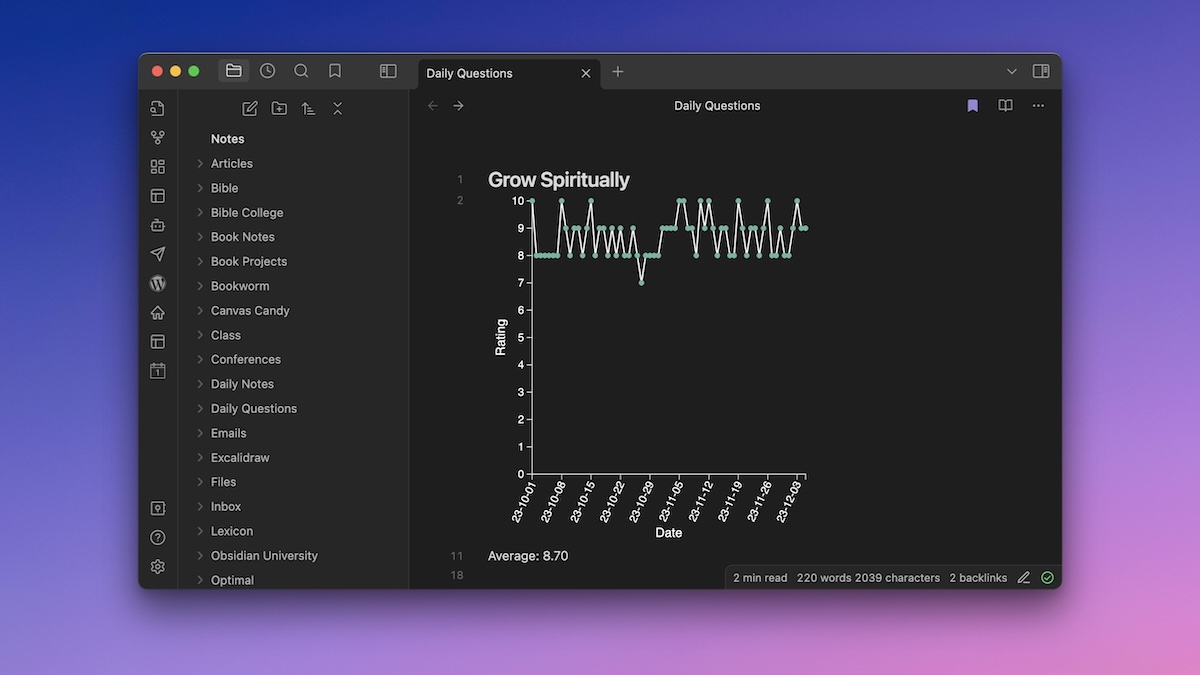
I also record and journal entries, wins, and gratitude in my Daily Notes in Obsidian. I’ll also go back and review these entries, which helps set the stage for the retrospective section a little later on.
The second thing I do is review my LifeTheme and personal core values to make sure they still resonate with me (a LifeTheme is my term for a personal mission statement). I almost never make changes here, but I give myself permission to if I feel that something needs to be modified.
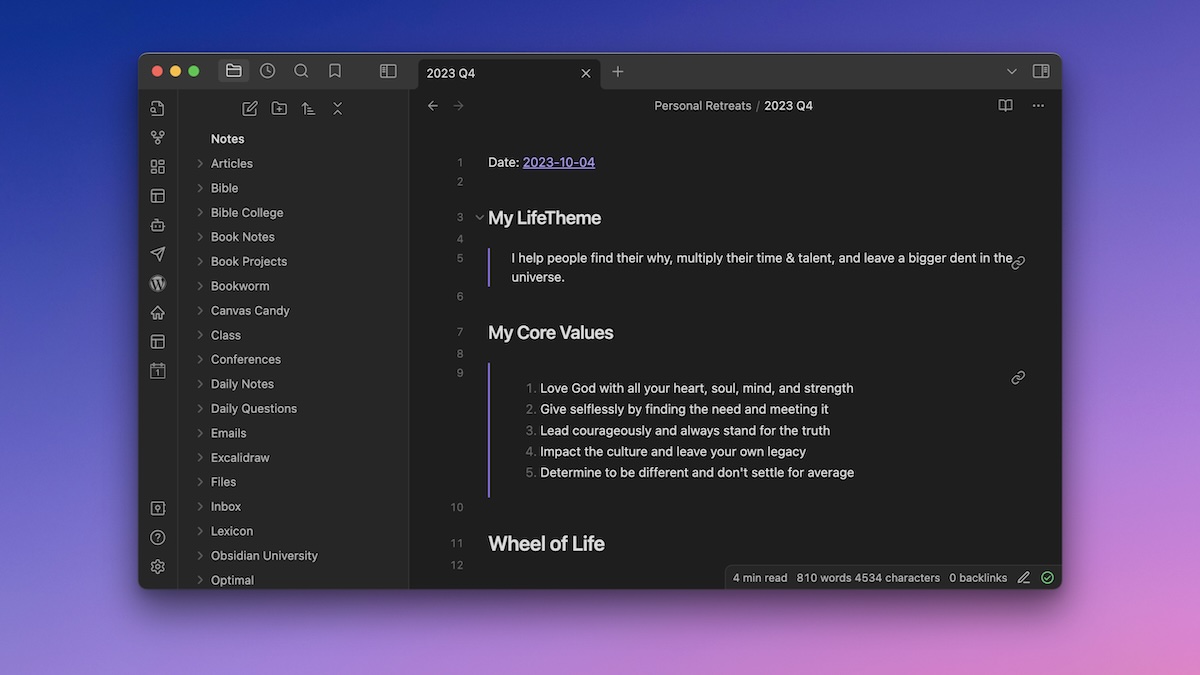
The next thing I do is fill out what I call the Wheel of Life. I’ve seen lots of different versions of this before, but basically I identify 8 areas of my life I want to keep tabs on and rate my current happiness within those 8 areas:
- Spiritual
- Career/Work
- Love/Relationship
- Health/Fitness
- Personal Growth
- Fun/Recreation
- Social
- Finance
For this, I use a plugin called Obsidian Charts. The type of chart is a polar area chart, and it looks like this:
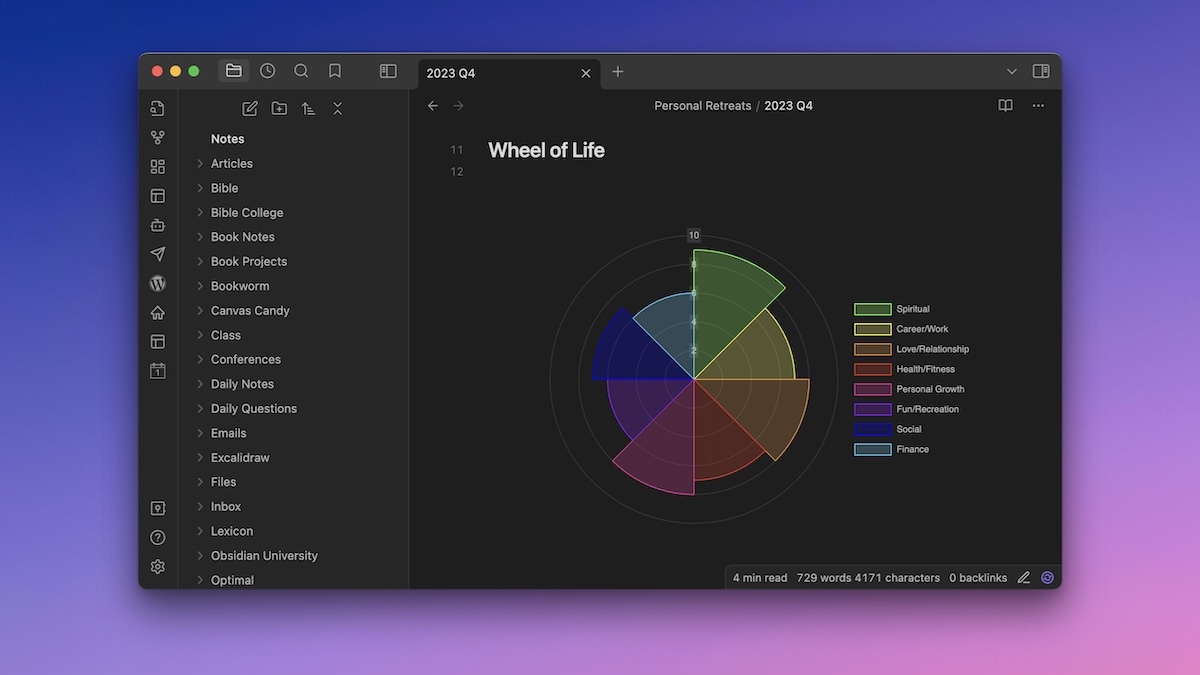
Here’s the code I use:
```chart
type: polarArea
labels: [Spiritual,Career/Work,Love/Relationship,Health/Fitness,Personal Growth,Fun/Recreation,Social,Finance] series:
- title:
data: [9,7,8,7,8,6,7,6] tension: 0.2
width: 80%
labelColors: true
fill: true
beginAtZero: true
rMax: 10
bestFit: false
bestFitTitle: undefined
bestFitNumber: 0
legendPosition: right
```
I also go through and create headers for each section and add a few bullets as to why I gave the score I did for that particular area:
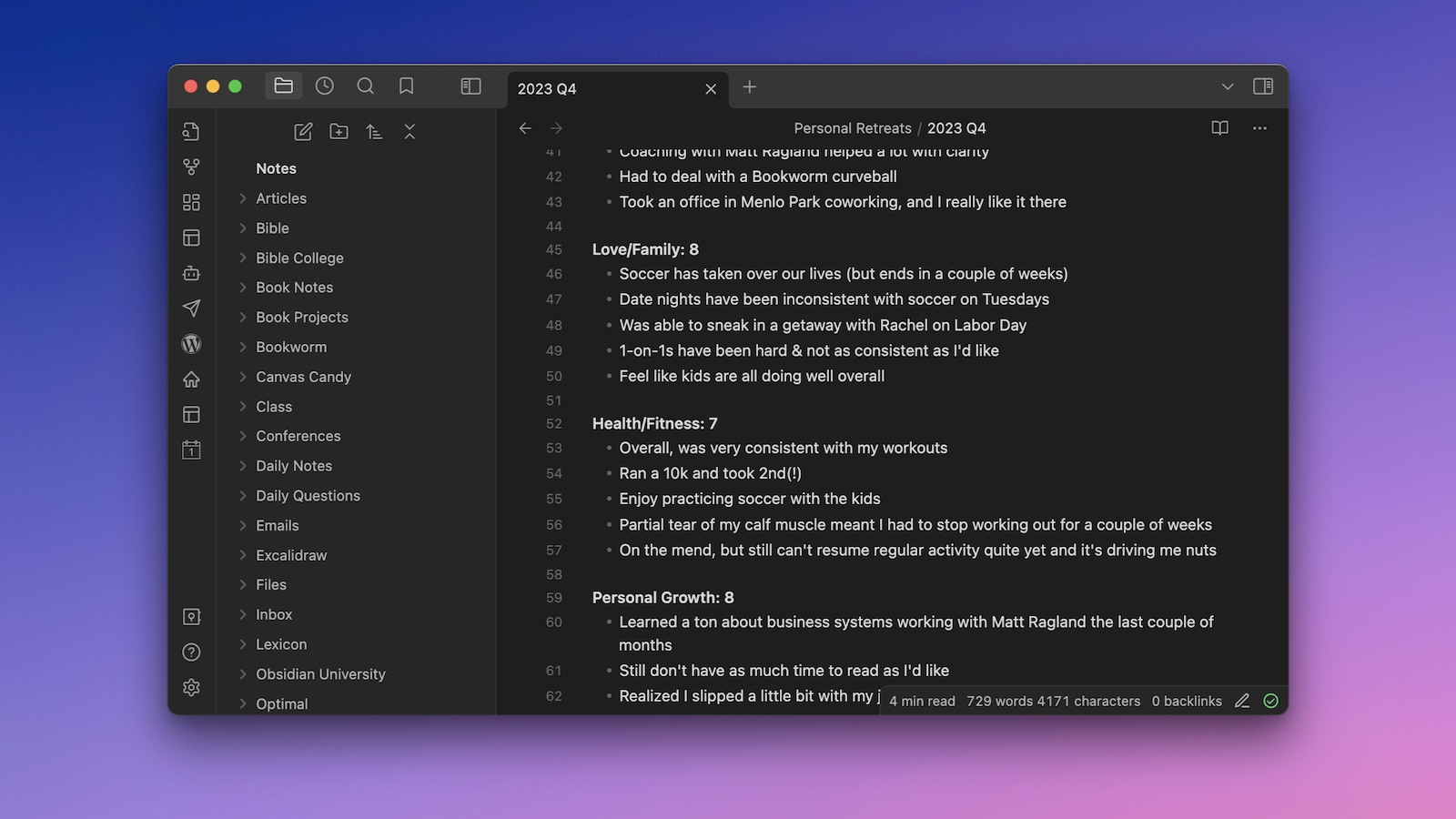
Next, I review my ideal future. This is a separate note that I put together that describes in detail what a day in the life of future-me looks like:
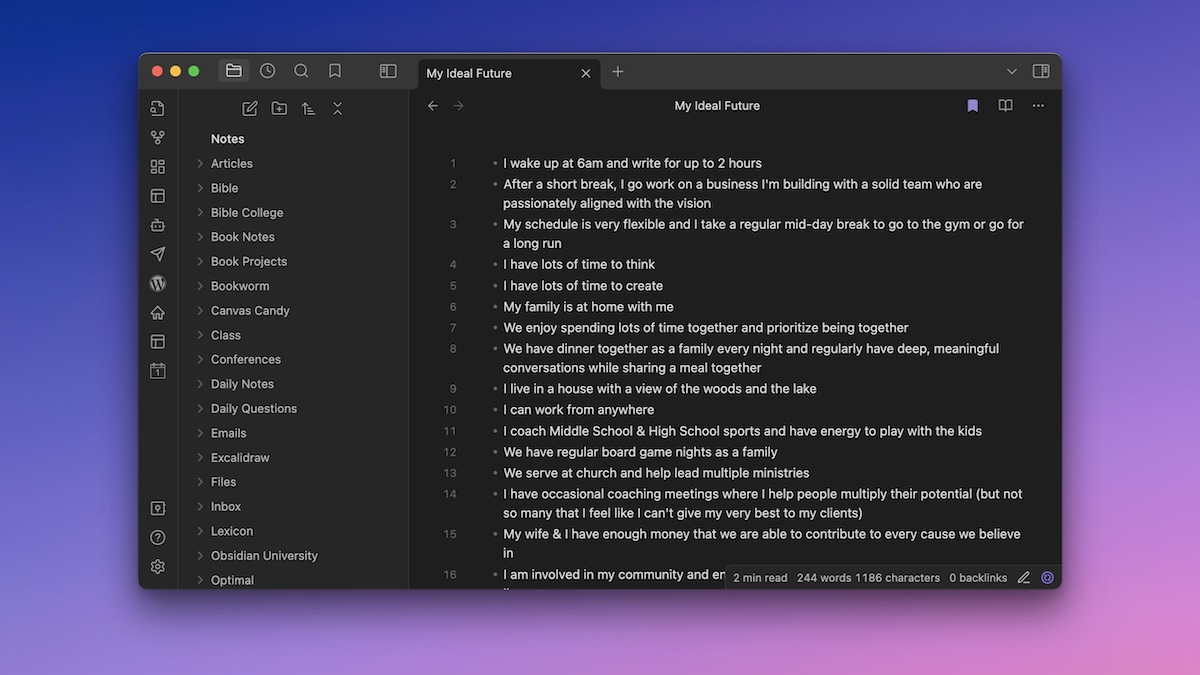
I don’t often change this either, but if something does come to mind, I’ll add or edit this as applicable.
The next part of my personal retreat process I call The Retrospective and I break it up into two parts. The first part is where I reflect on the last 90 days and jot down everything that comes to mind in response to three questions:
- What did I accomplish?
- What went well?
- What could have gone better?
This helps me recognize my accomplishments, celebrate my wins, and highlight the broken processes or systems that I might want to tweak for next time.
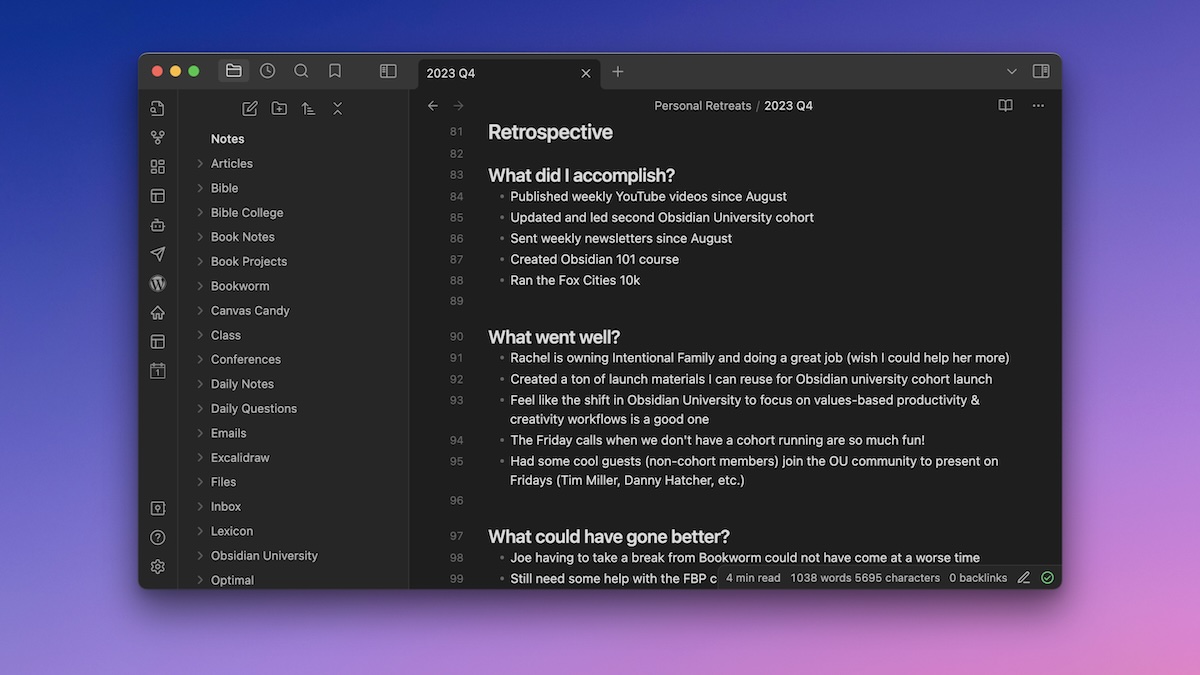
At this point, I usually take a break and get some food. I feel it’s important to stretch out the personal retreat over an entire day, and taking a strategic break in the middle helps me re-center and re-energize before going back into some intense thinking time.
After lunch is the second part of The Retrospective. During this session, I write down responses to three key questions:
- What should I START doing?
- What should I STOP doing?
- What should I KEEP doing?
These questions are purposefully vague, as I feel it encourages my brain to be a little more creative in finding answers.
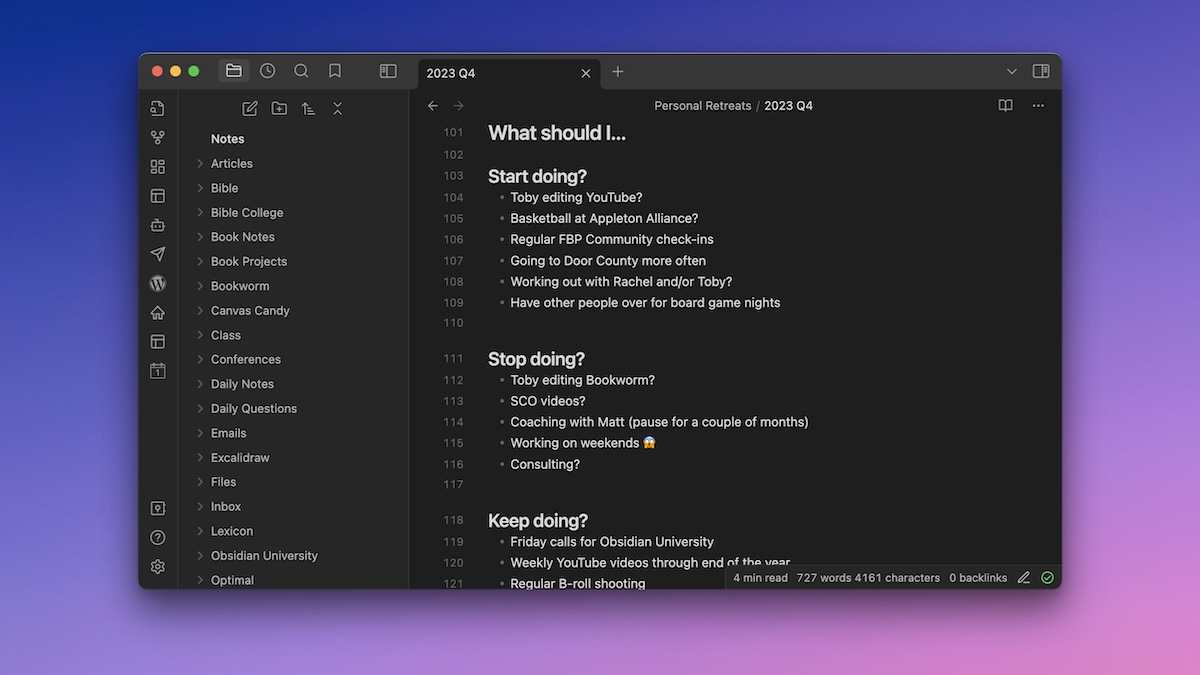
The trick with this part is to stay with it long enough. Usually your brain will come up with a few things right away and then you’ll hit a wall after about 20 minutes. At this point, you’ll feel like it’s time to move on, but DON’T! If you stick with it (I set aside two hours just for this part), you’ll break through a mental barrier and start coming up with the really good stuff.
Another important detail here is that while my lists include everything that comes to mind, I always pick at least one thing to take action on from the stop doing section. This naturally builds in margin so I can engage with new opportunities that are exciting to me without feeling overwhelmed.
After The Retrospective, it’s time to start planning for next quarter. I select 1-3 goals that I want to accomplish over the next 90 days and list those at the bottom of my Personal Retreat document. Then I break them down where necessary and identify milestones (where necessary) and habits that I want to take action on consistently that will help me make progress toward the completion of the goals.
Finally, I make sure I have time and space to implement those habits and routines by revisiting My Ideal Week. I actually just did a version of this for the Focus Like a Boss session Shawn led recently:
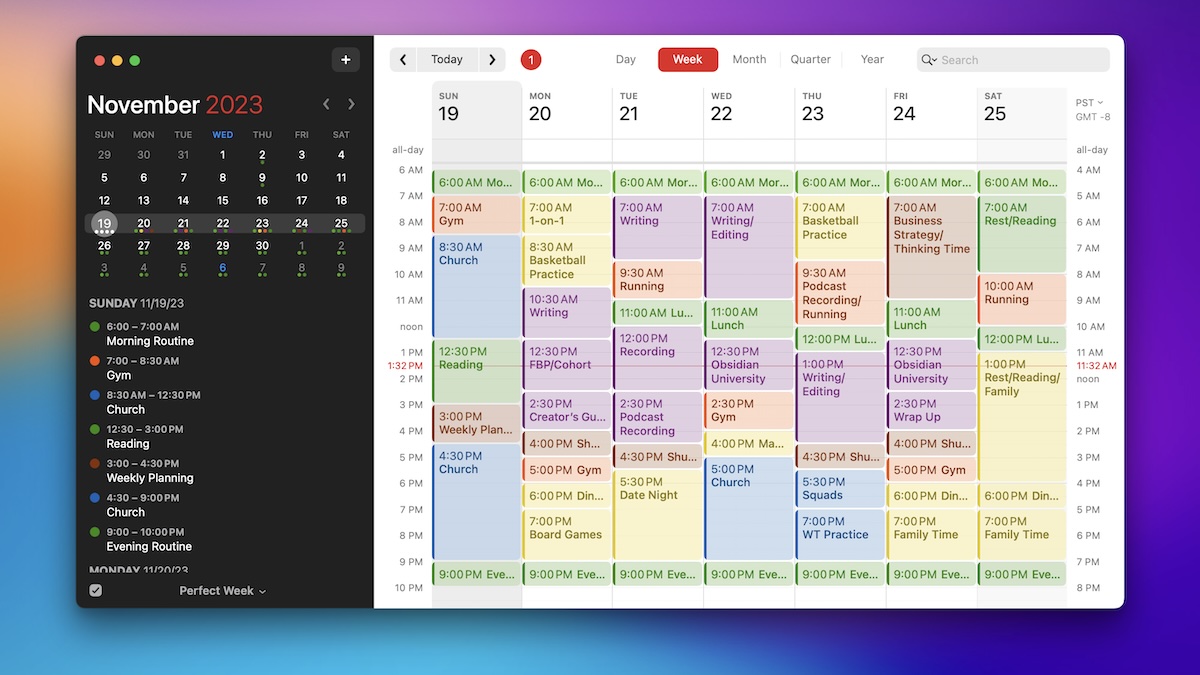
This calendar view is aspirational, but it helps me to think about what my schedule could look like. Not every day is going to look like this plan, but it helps me protect time for the things that are really important and gives me an anchor when I sit down to plan my day the night before.
A Few Other Tips for Your Personal Retreat in Obsidian
Here are a few other tips I’ve discovered over the years to help make personal retreats in Obsidian more effective.
Review Your Personal Retreat Regularly
Once I’m done with my Personal Retreat, I regularly refer back to it to make sure I’m still in alignment with what I decided to focus on. In Obsidian this is easy because you can just add a link to the note title inside of double-brackets anywhere to link to the note.
I like to add this link to my Dashboard note so I see it when Obsidian opens. I’ll occasionally look at this during the week, but I always look at it before doing my weekly plan.
Create a Template
Once you figure out what tweaks you want to make to your own personal retreat process, I highly recommend you make a template. This allows you to add the bones of your personal retreat note to a new blank note quickly, then you can just fill out the details as you go.
If you need help setting up templates in Obsidian, there’s a video on how to do it here.
Use Periodic Notes
While you can certainly use standalone notes for your personal retreats (I did this for years), there’s a plugin called Periodic Notes that allows you to assign notes to specific time periods:
- Daily
- Weekly
- Monthly
- Quarterly
- Yearly
Each time period allows you to set 1) the naming convention for the new note, 2) the location to store the note in, and 3) the template to use when creating a new note.
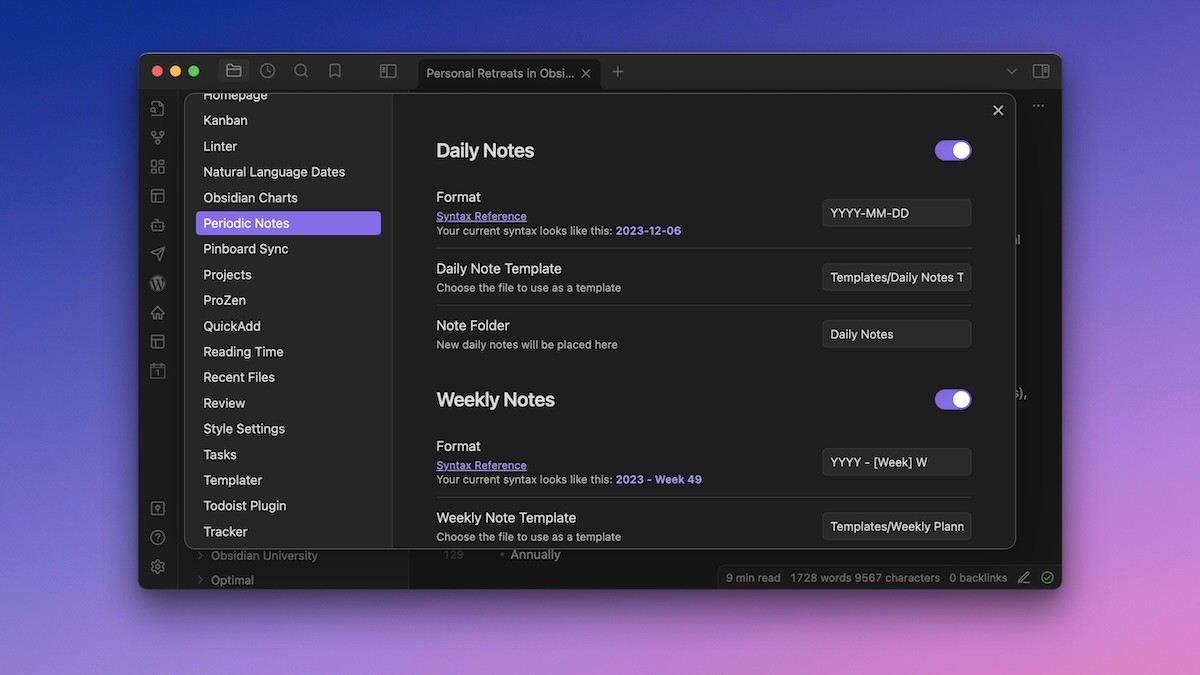
Once you have a note for the quarter, you can also open it directly from the Command Palette by running the Open Quarterly Note command.
Conclusion
That’s an in-depth look at my personal retreat process. And if you want to see how this all comes together for me, I’ve got a YouTube video where I walk through the whole thing from my last quarterly retreat.
But the real value here is not in following my exact process — it’s in creating the time to think about things. I highly encourage you to do your own personal retreat as it’s a great way to gain the motivation you need to take action on what’s important and the clarity to cut the things that aren’t.
📈 A Blueprint for Breakthrough
Personal Retreat Gameplan: A blueprint for getting back and staying on track with your schedule, goals, time, and energy.
If you want to level up your goal setting and keep your schedule under control, then incorporating a Personal Retreat is a must.
👉 A repeatable process to keep you on track and maintaining focus on the most important stuff.
👉 A “time out” that forces you to STOP doing the things that aren’t working so that you don’t continue to just pile on and pile on.
👉 A structure that helps you to make decisions about your life
Getting here is simpler than you may think. In fact, you can get going in just one day. We’ve put together a complete structure and blueprint for what we call a Personal Retreat Day.
